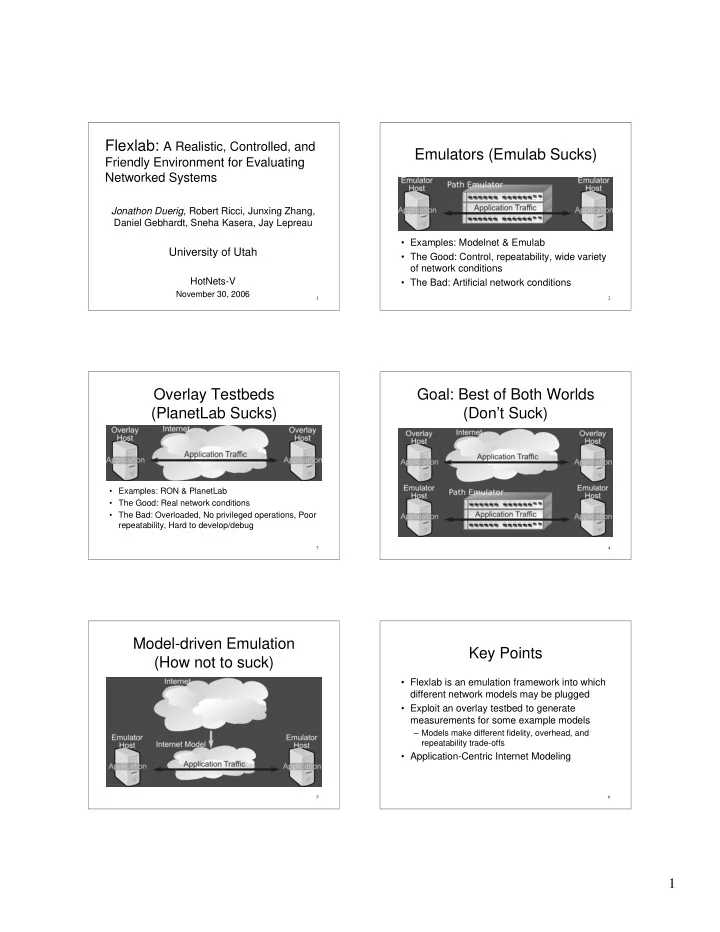

Flexlab: A Realistic, Controlled, and Emulators (Emulab Sucks) Friendly Environment for Evaluating Networked Systems Jonathon Duerig , Robert Ricci, Junxing Zhang, Daniel Gebhardt, Sneha Kasera, Jay Lepreau • Examples: Modelnet & Emulab University of Utah • The Good: Control, repeatability, wide variety of network conditions HotNets-V • The Bad: Artificial network conditions November 30, 2006 1 2 Overlay Testbeds Goal: Best of Both Worlds (PlanetLab Sucks) (Don’t Suck) • Examples: RON & PlanetLab • The Good: Real network conditions • The Bad: Overloaded, No privileged operations, Poor repeatability, Hard to develop/debug 3 4 Model-driven Emulation Key Points (How not to suck) • Flexlab is an emulation framework into which different network models may be plugged • Exploit an overlay testbed to generate measurements for some example models – Models make different fidelity, overhead, and repeatability trade-offs • Application-Centric Internet Modeling 5 6 1
Flexlab: Application Flexlab: Application Monitor 7 8 Flexlab: Measurement Flexlab: Network Model Repository 9 10 Flexlab: Path Emulator Flexlab: Feedback 11 12 2
Imagine Ideal Fidelity ACIM: Application-Centric Internet Modeling 13 14 ACIM Architecture ACIM Challenges • Hardening implementation to deal with PlanetLab unreliability • CPU starvation on PlanetLab – Host artifacts in throughput – Packet loss from libpcap • Reverse path congestion • Measuring bottleneck queue size in time • Discovering when bottleneck link is saturated 15 16 ACIM Network Conditions ACIM Available Bandwidth • Throughput == available bandwidth iff agent is saturating && bottleneck link is saturated • Agent saturating ! socket buffer full • Bottleneck queue saturated ! queue filling up ! RTT increasing recently 17 18 3
Sample Experiment Sample Results 19 20 Sample Results Sample Results 21 22 Sample Results Network Model Trade-offs 23 24 4
Sample Real Application: BitTorrent. BitTorrent w/ ACIM Model with Static Model 25 26 BitTorrent w/ PlanetLab Conclusions • Contribution: Modeling Framework for Emulation – Models can allow the experimenter to trade-off fidelity, repeatability, and overhead • Contribution: Application-Centric Internet Modeling • Contribution: Running on Emulab and PlanetLab in alpha stage What is “correct”? Challenging to determine; work-in-progress. 27 28 Why not just add more nodes to every Backup Slides PlanetLab site? (cf. public review) • Remaining problems: – Poor repeatability – Hard to develop/debug – No privileged operations • Malicious traffic cannot be tested • Some Flexlab network models reduce network load • Emulab node pool stat muxed and shared more efficiently than per-site pools • Overload can (will?) still happen with PL’s pure shared-host model • Major practical barriers: admin, cost 29 30 5
PlanetLab Overload (What) PlanetLab Overload (Why) • Only a few nodes per site – Sites supply their own nodes – No incentive to increase number of nodes • No admission control • No resource guarantees • No incentive to minimize usage • Typically tedious to set up experiments (exceptions: Emulab portal, Plush, other?) 31 32 Network Model 1: Static Static Trade-offs • Low fidelity • Fixed continuous overhead • Complete repeatability 33 34 Network Model 2: Dynamic Dynamic Trade-offs • Moderate fidelity • Overhead proportional to number of paths used • High repeatability 35 36 6
Low-Frequency Measurements Miss Flexlab and VINI Changes (Changepoint Analysis) Entirely different kinds of realism and control 20 Sec. 2 Sec. • Flexlab: passes “experiment” traffic over shared path Period Period Path – Real Internet conditions from other traffic on same path, but app. traffic is not from real users Src Dest Count Count Avg magnitude of – Control: of all software 2 sec changes – Environment: friendly local dev. environ, dedicated hosts Commodity Commodity 2 20 39% • VINI: can pass “real traffic” over dedicated link – Real routing, real neighbor ISPs, potentially traffic from real users, but network resources are not realistic/representative Commodity Internet2 1 13 15% – Dedicated pipes with dedicated bandwidth, that insulate experiment from normal Internet conditions – Control: restricted to VINI’s APIs (Click, XORP, etc) Internet2 Internet2 0 0 - – Environment: distributed environ; shared host resources. 37 38 Dealing with PlanetLab CPU Starvation on PlanetLab Unreliability • Host Artifacts • Our initial design was optimistic – Long period when agent can’t read or write • Nodes fail – Empty socket buffer or full receive window – There is no set of ‘good nodes’ – Solution: Detect and ignore – Agents must react robustly to node failure • Packet loss from libpcap • Most errors are transient – Long period without reading libpcap buffer – Log everything – Many packets are dropped at once – Replay packet analysis – Solution: Detect and ignore 39 40 Handling Reverse Path Measuring Bottleneck Queue Congestion Size • Can cause ack compression • Important to emulate loss episodes due to congestion • Throughput Measurement • No one knows how in terms of – Throughput numbers become much noisier bytes/packets – We abuse the TCP timestamp option • Easier to measure in terms of time: – PlanetLab: homogenous OS environment – Extending it would require hacking client – full = RTT when queue is full • RTT Measurement – empty = RTT when queue is empty – queue_time = full - empty – Future work 41 42 7
Initial Conditions Path Emulator (detail) • Needed to bootstrap ACIM – ACIM uses traffic to generate conditions – But conditions must exist for first traffic • We created a measurement framework – All pairs of sites are measured – Put data into measurement repository • Set initial conditions to latest measurements 43 44 8
Recommend
More recommend